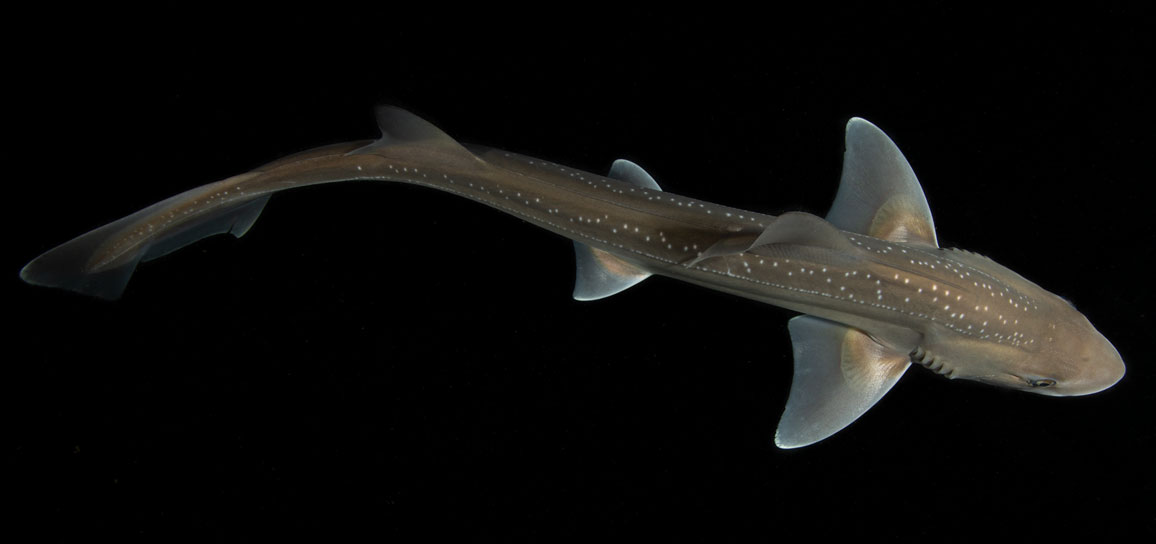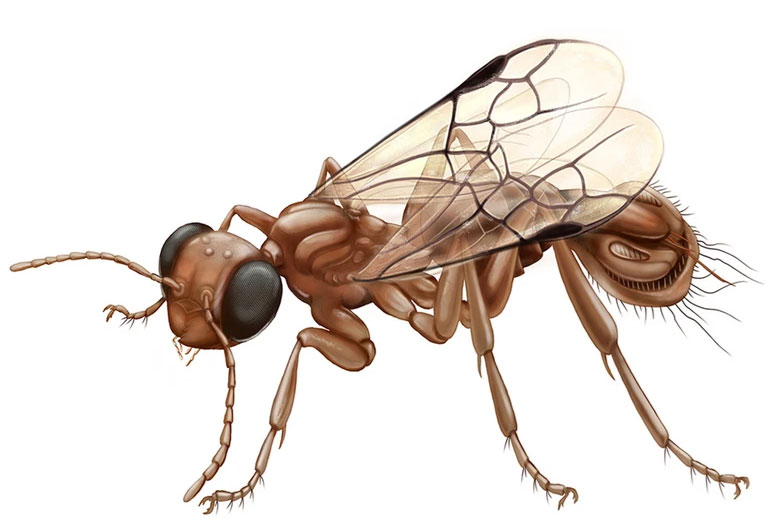
This Article From Issue
July-August 2025
Volume 113, Number 4
Page 204
In this roundup, associate editor Nicholas Gerbis summarizes notable recent developments in scientific research, selected from reports compiled in the free electronic newsletter Sigma Xi SmartBrief.
First Shark Sounds Heard

Paul Caiger
Scientists have documented the first case of a shark purposely making sounds. The event occurred during a hearing study of 10 New Zealand rig sharks (Mustelus lenticulatus). While being handled underwater, the sharks made loud clicks across a wide frequency range and reached a peak that would be audible to many marine mammals. Elasmobranchs such as sharks, rays, and skates have long been considered silent, making noises only while eating, swimming, or colliding. That view began to change in 2022, when divers in Indonesia and Australia noted that two stingray species made clicking noises as they approached. Rig sharks are small predators that dwell in shallow coastal waters and feed on crustaceans and sea worms. Fish make sounds in a variety of ways, from using their swim bladders as drums to stridulating—rubbing together hard body parts such as pectoral spines. But rig sharks have no such mechanisms, so the team led by scientists at the University of Auckland in New Zealand proposed they make clicks by snapping their flat, platelike teeth together. More research is needed to determine if the sharks click only when stressed or if they also make sounds in more natural settings for defense, warning, or communication.
Nieder, C., E. Parmentier, A. G. Jeffs, and C. Radford. 2025. Evidence of active sound production by a shark. Royal Society Open Science 12:242212.
Galactic Counter-Spin Bias
Viewed from our Milky Way, about 50 percent more galaxies rotate clockwise than counterclockwise, according to an analysis of James Webb Space Telescope (JWST) images by Lior Shamir of Kansas State University. The deep-field observations of a much-studied area near the galactic pole could raise questions about the standard cosmological model, which assumes isotropy—that the universe is essentially the same in all directions at large scales. Thus, galactic spin should be randomly and evenly distributed. But the farther back in time JWST peered with its three infrared bands, the more pronounced the rotational difference became, suggesting that the infant cosmos had a spin bias, perhaps due to some mechanisms or conditions governing the Big Bang or the early universe. Such anisotropy might comport better with more speculative models of the cosmos, such as the notion that our universe occupies a black hole, although some critics question whether the small sample of 263 galaxies is enough to support larger conclusions. Shamir says perspective factors and Doppler effects from galaxy rotation affected the results, but not enough to alter the interpretation. He adds that the spin difference, though curious, may require no radical hypotheses to explain—just the odd, tricky physics of galaxy rotation.
Shamir, L. 2025. The distribution of galaxy rotation in JWST Advanced Deep Extragalactic Survey. Monthly Notices of the Royal Astronomical Society 538:76–91.
Wasp with a Flytrap Abdomen

Xiaoran Zuo
Scientists have discovered a bizarre species of extinct parasitic wasps whose abdomens resembled Venus flytraps (Dionaea muscipula)—the first time such a structure has been observed on an insect. Dubbed Sirenobethylus charybdis, the wasp was an early evolutionary offshoot of Chrysidoidea (a superfamily of parasitic wasps). The unusual feature suggests the existence of a wide array of parasitic mechanisms 99 million years ago that no longer occur. The team, led by researchers from Capital Normal University in Beijing, found 16 adult females whose abdominal segments were specialized into flaps bordered by bristle-like hairs, or setae, that resemble the trigger hairs D. muscipula use to trap insects and arthropods. The flaps were preserved in amber in positions indicating they were likely used for grappling a host, into which the wasp would then have inserted its eggs. Unlike most modern Chrysidoidea, the wasps likely were koinobiont parasitoids, meaning their hosts could stay alive while the wasps’ larvae developed and consumed them. The wasps were found in a Myanmar fossil site famed for preserving mid-Cretaceous insects in amber, sometimes even retaining soft tissues and capturing insects in the middle of characteristic behaviors.
Wu, Q., L. Vilhelmsen, X. Li, D. Zhuo, D. Ren, and T. Gao. 2025. A cretaceous fly trap? Remarkable abdominal modification in a fossil wasp. BMC Biology 23:81.
Proof Gladiators Fought Animals
Researchers examining the remains of a late 3rd-century male exhumed from a Roman cemetery near York, England, have found the first physical evidence of human–animal gladiatorial combat. Until now, the belief that Roman elites pitted people against animals in events ranging from mythic reenactments to criminal executions stemmed mainly from ancient writings, artworks, and monuments. In addition to signs of repeated interpersonal violence, the 26- to 35-year-old male showed perimortem trauma (injury near the time of death) on both sides of his pelvis. When the team, led by a researcher at Maynooth University in Ireland, compared 3D scans of the pelvic gouges with bone lesions left by weapons or several candidate animals, they found that they most closely matched marks made in fresh carcasses by cheetahs, lions, tigers, and leopards in zoos. The findings lend context and credence to the existence of Roman spectacles called venationes (“beast hunts”), which reputedly included bears, large cats, and large herbivores (such as elephants, wild boars, stags, and bulls). They also suggest that Rome once devoted enormous resources to importing and maintaining wild animals.
Thompson, T. J. U., et al. 2025. Unique osteological evidence for human–animal gladiatorial combat in Roman Britain. PLOS One 20: e0319847.

American Scientist Comments and Discussion
To discuss our articles or comment on them, please share them and tag American Scientist on social media platforms. Here are links to our profiles on Twitter, Facebook, and LinkedIn.
If we re-share your post, we will moderate comments/discussion following our comments policy.